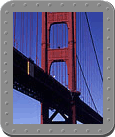|
|||||||

|
| The Golden Gate Bridge is an obvious example of a bridge. Have your students look for less noticeable bridges near their school. Click on the image for larger view. |
![]()
Math
In the classroom, students become interested in exactly how much weight
their bridge will hold. Students can go to the chalkboard to add together
the weights of the books (or bodies) which their bridges would hold. In
a fifth-grade class, the students took the weight of a book and multiplied
it by the total number of books on the bridge. When they ran out of one
type of textbook and had to use another, the problem became more complex.
Efficiency
One of the interesting ways to assess the bridges is to look at design
efficiency. By efficiency, we mean how much newspaper it takes to hold
up a pound of load. To find this, first determine the amount of newspaper
used by weighing it. Then, divide the weight of the load by the weight
of the bridge itself. The larger the result (load per unit amount of newspaper),
the more efficient your bridge design.
Real Life
Students can look for bridges in the world around them. There are obvious
examples, such as monuments like the Golden Gate, but there are many other
less noticeable examples as well. Students can look for roads crossing
creeks, pedestrian overpasses, or even second-story floors in their school.
There are many books and videos which discuss the history and construction
of bridges.
Build with Less
A natural extension of this activity is to ask the class: "What is the
minimum amount of newspaper and tape that you would need to support one
(or more) books?" Have the class try to build a "minimalist" bridge. This
challenge should be preceded by a discussion of why one would wish to
design a minimalist bridge. This could lead to discussions of "real world"
considerations of cost factors in building. It also introduces a constraint
that forces the students to look more closely at and apply what they have
learned about what makes their bridges strong.

